When I was trying to decide which local thoroughfare to tackle next, Grand Avenue sprang to mind as an archetypal Chicago street. Years ago I hiked all of Western and Milwaukee Avenues. Recently I completed Halsted and Archer as part of a project to walk the length of all the city's major streets while seeing the sights, eating good, cheap food and visiting interesting dive bars.
Grand started out as a rough Indian trail, originally called Whisky Point Road, according to Streetwise Chicago by Don Hayner and Tom McNamee. Its name is believed to come from the city's first town president, Col. Thomas, J.V. Owen, who declared, "Chicago is a grand place to live."
Nowadays the avenue runs about 12 miles through town, heading southeast from the suburb of Elmwood Park, then due east from Western Avenue to Navy Pier. The street provides an overview of the city's architectural and transportation features. Ranging from old-fashioned, low-rise retail to the skyscraper canyons of River North, crossing Metra tracks, the Kennedy Expressway, the Chicago River, three CTA lines and Lake Shore Drive, ending at Lake Michigan, Grand represents the city's center of gravity.
On the warm, gray morning of Wednesday, June 4, I caught the #72 North Avenue bus west from Humboldt Park then transferred to the #65 Grand Avenue bus. After walking a couple blocks west from the terminal at 7030 W. Nordica St., I tagged the "Welcome to Elmwood Park" sign at Harlem Avenue, 7200 West, at 10am and backtracked into the Chicago community of Mont Clare.
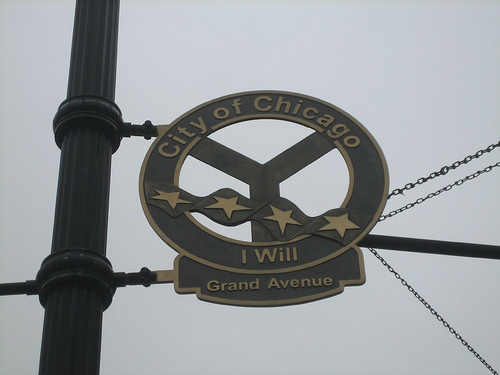
The neighborhood's business strip was streetscaped a few years ago with Frank Lloyd Wright-inspired pylons and new signs on the streetlamps that say "City of Chicago / I Will / Grand Avenue." But Mont Clare still feels like a care-worn small town from the 1950s. I passed Grand Cycle, 7160 West, which specializes in BMX and lowrider bicycles and skateboards, then crossed the street to gawk at a huge model schooner in the window of Julie's furniture, 7163 West. "Nice ship, huh?" said a woman pedaling by on the sidewalk. "Beautiful."
I returned to the Terminal Snack Shop, 7030 West, next to the bus turnaround, and downed some coffee and a bacon, egg and cheese sandwich on white toast as I admired the orange walls and oil paintings of lush landscapes with waterfalls and snow-capped mountains. I continued on past the castle-like Galewood-Mont Clare branch of the Chicago Public Library and Bill & Michelle's Question Mark Bar, 6918 West.
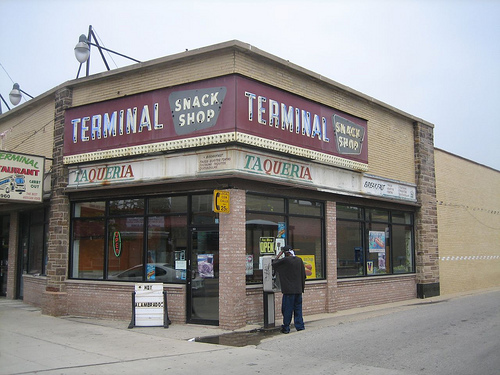
Soon I was jolted back into the modern era as I hit a nasty stretch of car dealerships, chain restaurants and the Bricktown Square shopping plaza. So it was refreshing when I saw something unique: the World's Largest Wagon outside the Radio Flyer corporate headquarters, 6515 West. It's 27 feet long with 8-foot diameter wheels; it took 100 gallons of red paint to cover it. Inside the lobby I read about the company's founder, Italian immigrant Antonio Pasin, who eventually produced the wagons on an automobile-style assembly line, earning him the nickname "The Little Ford."
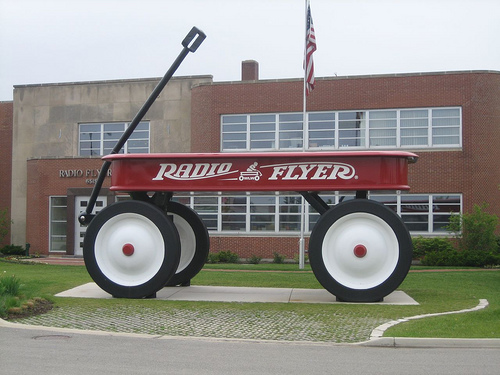
At Narragansett, 6400 West, small businesses appeared again, with many of the signs in Spanish. The menu at El Guanaco Salvadorian Restaurant, 6345 West, features pupusas — thick discs of corn or rice dough stuffed with various savory fillings — as well as platters of fried yucca and sweet plantains served with beans and sour cream. Paleteria Currucel, 6315 West, had a dozen or so Mexican ice cream carts parked inside. I tried on some cowboy shirts next door at Almacenes Western Wear but decided they were too flashy for me to pull off.
Soon afterwards the street became residential for the first time on my walk, with several evergreen trees — rare in this city — including a few beautiful blue spruce. At Melvina, 6200 West, I was reminded of an old off-color joke: "What three streets in Chicago rhyme with the name of a woman's sex organ?" Please ask someone else for the answer.
Supreme Frozen Products, 5813 West, is a wholesaler specializing in the kind of tamales sold at hot dog stands across Chicagoland. I recently read a piece in The Reader about a foodie who's researching the origin of the Mother-in-Law sandwich, a tamale in a hotdog bun, covered with chili. The man I talked to at Supreme said he had never heard of the Mother-in-Law. When I described it he said, "Oh, you mean a tamale boat?"
At busy Central Avenue, 5600 West, I saw Prosser Vocational High School and the vast green expanse of Hanson Park to my left. To my right were a Cook County Circuit Court building and the Chicago Police Area Five headquarters. In June of 1998, after a Bulls game, police officers and civilians partied late into the night in the parking lot behind the police station. Officer George Wilson drove home drunk in his pick-up that morning and struck Sophia Latuszkin, 66, as she tried to cross Harlem Avenue in Elmwood Park. She was killed; he fled the scene as bystanders wrote down his plate number. Wilson was sentenced to five years in prison and only wound up serving 20 months.
A few blocks later outside a firehouse at 5252 West, a tiny pond was sunk into the pavement with a fountain fashioned from a fire hydrant and goldfish swimming in the murky, green water. I stopped into Del Rey Tortilleria, 5201 West, to buy some buenelitos, pieces of crisp fried flour tortillas covered with cinnamon sugar. A large shrine in the otherwise stark room included images of Jesus, Our Lady of Guadalupe and Pope John Paul II, plus flowers and big multicolored Christmas balls.
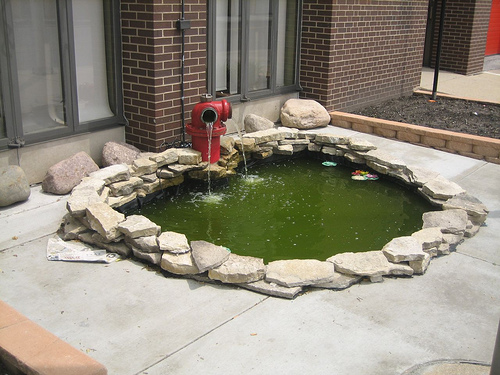
At Lemke Screw Products, 4911 West, I peeked through the window bars of the low industrial building to see workers laboring at big, old-fashioned lathes to the whir of machine belts and large fans. Up the street at Las Islas Marias, 4750 West, a big fiberglass lobster was perched above a sign for various seafood dishes, touting their health benefits: "Bienvenidos a su vitamina" — welcome to your vitamin. A block later the scenery changed once again to chain retail and giant parking lots again and I saw the rear end of the city's only Wal-Mart, 4655 West.
Outside a school bus garage at 4253 West, a group of heavy-set, middle-aged ladies, one of them sitting on a hydrant, smoked and joked as they killed time between runs. It was getting really hot and I was ready for a beer. A man in a Puerto Rican flag t-shirt pedaled by on a BMX bike, riding one-handed while eating a long, cherry Flav-R-Ice.
At Pulaski Avenue, 4000 West, Jimmy's Hotdogs, in business since 1954, had a large sign for Supreme Tamales featuring the image of an alluring senorita. Just east Cedric's Auto service was topped by a bearded fiberglass giant, a dead ringer for Paul Bunyan, holding up a piece of bent pipe.
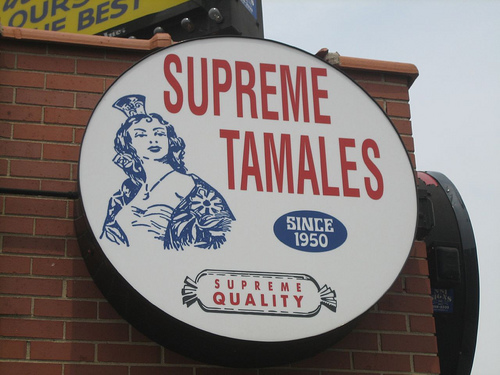
So far I had encountered mostly Latinos on the street with a smattering of Caucasians and African-Americans, but for the next few block I saw mainly the latter. Unfortunately I wasn't hungry enough yet for lunch at CJ's Diner, 3839 West, a soul food place recommended by a friend for its biscuits and gravy. The door of the C.O.G.I.C. church youth center, 3839 West, was flanked by paintings of graceful angels.
At Monticello, 3632 West, I could just make out the Sears Tower through the warm haze. I finally stopped for a cold one at the Lite Inn, 3614 West, the first open bar I'd noticed on the trip. A few patrons were conversing in Spanish with soft Caribbean accents as "The People's Court" played on TV. There wasn't much in the way of décor except for a few sombreros hanging from a wall. For some reason there was a whole row of Cook's Champagne bottles behind the bar.
The elderly, mustachioed bartender scrutinized my ID carefully before serving me an icy bottle of Corona with lime. Next to me a guy in a white apron, probably a cook from the Puerto Rican sandwich shop next door, sipped a Coronita, the 6.7-oz version. After all, it was still business hours.
A wonderful smell of pizza wafted out as I passed an industrial bakery at Spauding, 3300 West. Soon afterwards I spotted my first hipster of the day, a young white guy with long sideburns, a short-sleeve cowboy shirt and a Greek fisherman's cap, riding a yellow fixed-gear bike with a pad on the top tube emblazoned with a lightning bolt.
At an industrial building at 3100 West, I saw an odd sign for Nature House, "makers of the original aluminum purple martin bird feeder," so I rang the bell. Out came Larry Coffey, plant manager for Erva Tool & Manufacturing Co., which recently bought the birdhouse company.
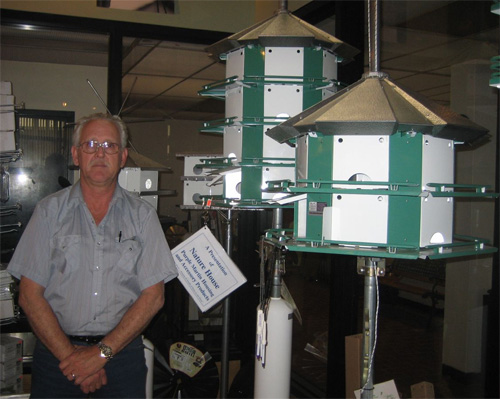
A transplant from Griggsville, in west-central Illinois, Coffey speaks with a country twang. He explained that purple martins migrate from South America to the U.S. each year. West of the Rockies they live in woodpecker holes and cactuses and build mud nests under highway overpasses, but for unknown reasons the birds can't build nests in the East and rely on man-made shelters.
He brought me into a showroom filled with various lawn ornaments and plant hooks as well as the large, pagoda-like feeders. A vintage sign showed a cartoon of a smiling martin with the legend "2,000 mosquitoes per bird." "They claimed a purple martin could eat 2,000 mosquitoes a day," said Coffey. "I do know that in Griggsville, when the martins were in town you didn't have to worry about bugs but when they left it was time to bring out the citronella."
Moving on, I passed by Taco El Jalciense Mexican restaurant, squeezed into a narrow triangular lot at the southeast corner of Grand and Chicago Avenue, 800 North A block later I saw a hypodermic needle lying on the sidewalk, something I've never noticed before. I walked along the massive Metra yard near California Avenue, 2800 West, then passed the Chicago School of Ballet, 2635 West.
As I walked by Smith Park, 2550 West, I remembered a recent article from the Chicago Journal about a controversy over creating a new garden at the park which is dividing residents along ethnic lines. Some who feel the park is part of the Ukrainian Village community want the garden to be a memorial to the Ukrainian famine, called the Holodomor, which killed millions of people in 1933. Others, who call the area Smith Park and consider it an Italian-American neighborhood, want the garden to be dedicated to police officer Michael Ceriale who was shot during a narcotics stakeout in 1998.
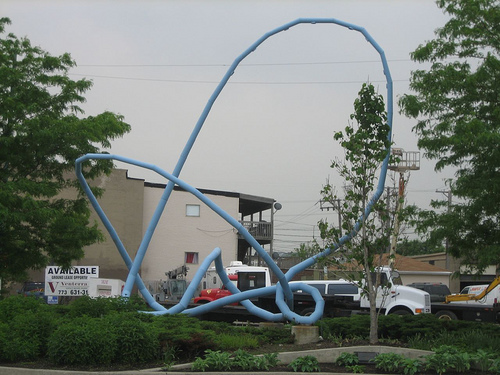
Soon I reached the site where Grand flattens out at Western Avenue, 2400 West, marked by Josh Garber's sculpture "Episodic," powder-blue steel pipes that loop into the sky in a Mobius strip-like form. It was 2:15pm and a cool breeze was blowing in from the lake.
I decided to stop for lunch at Hound Dog's Burgers and Teriyaki, 2252 West, a greasy spoon that serves Asian dishes like Bulgogi (Korean BBQ) as well as hot dogs, tacos, pizza puffs and other fast food staples. I got a big bowl of bibimbap: rice topped with marinated beef, carrots, cucumbers, bean sprouts, spinach and a fried egg with a side of red chili sauce — delicious.
Down the street at 1924 West, I spotted an odd house I had passed many times before on my bicycle but had never really noticed. The second story has sort of a Wild West-style façade, and in addition to a large American flag and a few geese ornaments the place has year-round Christmas decorations: lights, snowmen and a dozen plastic candy canes attached to the railing of the balcony.
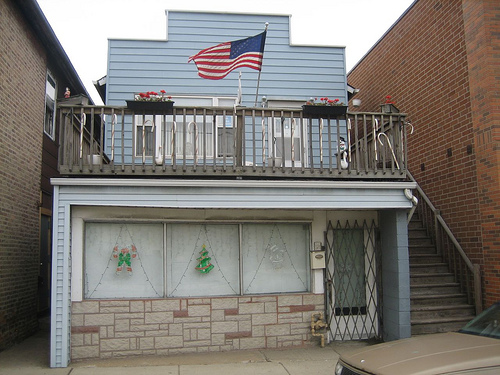
At Wood St., 1800 West, the downtown skyscrapers started to come into focus. I passed by Betty's Blue Star Lounge, 1600 West, formerly a dive bar and now a velvet rope dance club. Signs on the window said "Dress code strictly enforced" and "Notice: per Chicago ordinance this premises under 24-hour video surveillance."
I was entering the dense Near West Side business strip which includes many old-school Italian restaurants, grocery stores and bakeries, as well as trendy newer bars and cafes. Above the Twisted Spoke, 1226 West, a motorcycle-themed bar, a skeleton perched on an antique bike rotated in the sky. Next door a fluffy, gray cat snoozed in the window of an empty storefront.
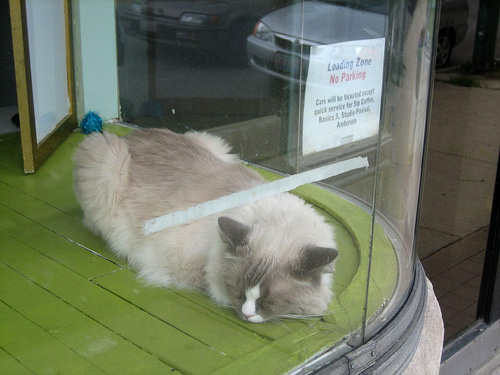
The sun burst through the clouds as I crossed over the Kennedy Expressway around 900 West and the break in the buildings provided a panoramic view of the Loop above the canal of roaring traffic. At Halsted, 800 West, I passed a Blue Line station as well as Richard's Bar, an old man bar with a storefront painted red, white and green and photos of famous Italian-Americans hanging inside.
Just east of Halsted I ducked into the Salvation Army store at 509 North Union to continue my search for a summer shirt. Years ago, I'd gone there to shop for a mattress and was looking at single beds. The older lady who helped me said, "Young man, I suggest you buy a double bed because there may be some situations in the future where that may be useful." On this visit, as I went upstairs to the clothing department to find people assisting an elderly woman in a wheelchair who seemed to be having some kind of seizure. As I left, paramedics from the fire department were storming into the thrift shop.
As I approached the Chicago River I found many new residential high-rises sprouting up and the Kennedy's Ohio Street feeder was visible and audible to my left. I enjoyed the fine view of the Loop from the bridge, then went downstairs to check out a new fountain and river walk by Kingsbury Plaza, a tall, blue tower. Historically, Chicago's riverfront has been underutilized but nowadays the City requires developers to create sections of walkway when they build on its banks, so eventually you may be able to walk and bike along the entire length of the river.
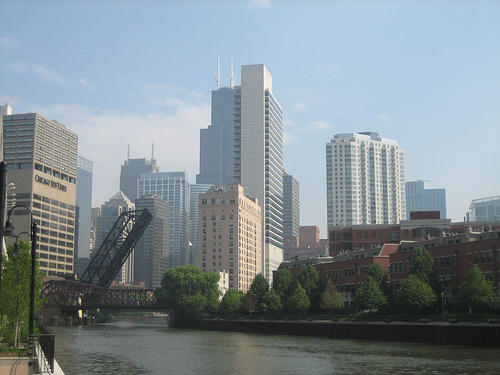
I passed under a speeding Brown Line train at Franklin, 300 West, and Grand became one-way westbound a block later. The Anti-Cruelty Society animal shelter, 157 West, was adorned with Art Deco bas-reliefs of robed figures nurturing a cat, a dog and a horse. Looking south as I strolled, I spied the twin corn cobs of Marina City at State Street, 1 West, and then at Wabash, 30 East, the Trump Tower, whose looming, zig-zag structure echoes that of the Sear Tower. At Rush St., 130 East, all four corners of the intersection were occupied by beige, concrete boxes with chain restaurants or a Marriot lobby at ground level, topped by several stories of windowless parking garage. Pretty depressing.
After passing through the sketchy dimness of Lower Michigan Avenue for a block, I emerged into the sunlight to see that a strange, low-lying fog obscured Navy Pier, my finish line. I stopped into Boston Blackies, 162 East, a tavern I'd been meaning to check out for a while. The décor was a 1970s interpretation of the 1920s, with houseplants, lots of brass and a mural behind the bar showing a glamorous gangster scene: big city skyscrapers, a naked moll leaning on the back of a chair, and the large face of Blackie himself, a handsome, dark-eyed youth with slicked-back hair.
I ordered a Boston Blackies Amber, made by west-suburban Two Brothers Brewing Company, and listened to attorneys and other late-middle aged folks talk politics with the bartender and the owner, an elderly Greek immigrant. Local political fundraiser Tony Rezko had just been convicted of several counts of corruption. "I bet he'll be real popular in prison," said the barkeep. A news report on TV said Chicago was chosen as one of the top finalists to host the 2016 Olympics. "I wouldn't blame people if they'd rather go to Rio than Chicago," I conceded. "In Chicago you get handguns," countered the lawyer at the next stool. "In Rio it's machine guns."
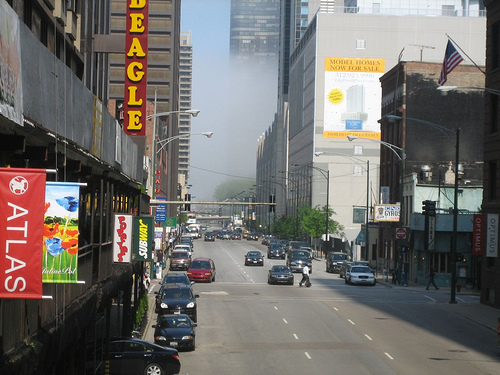
With only a few blocks left I strolled past an old-fashioned neon parking sign and the rusty-looking Time-Life building at McClurg Court, 400 East, with its shiny, copper-colored windows. It grew chilly as I walked through a cloud of mist which almost completely concealed the monolithic Lake Point Tower condo building.
After I passed under the eight lanes of Lake Shore Drive, 600 East, and saw the pier entrance a couple blocks away, my cell phone rang. It was my high school classmate Chris O'Brien, now a D.C.-based "beer activist" and author of the book Fermenting Revolution: How to Drink Beer and Save the World. Chris' book is a manifesto on the social and environmental impact of choosing craft-brewed beverages over Big Beer. He's currently working on a similar book about coffee. You can read his beer blog at beeractivist.com.
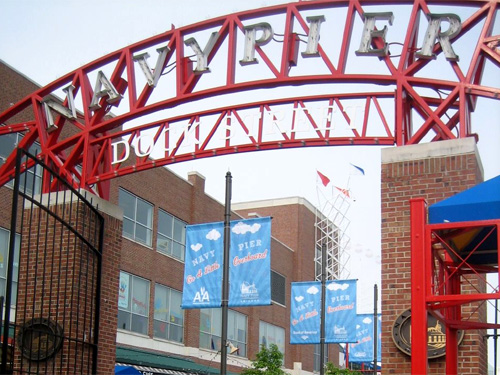
Chris' day job involves advising corporations, schools and other institutions on how to buy "green." He was in town for a conference on ecologically responsible procurement practices and he wanted to know if I'd to meet up for a cold one. "Where are you?," I asked. "Navy Pier," he answered. In a moment we met up at the gate, beside the cool blue of Lake Michigan. We retreated a few blocks on Grand to meet up with his colleagues at D4, a nouveau-Irish bar at 345 East, where we toasted the coincidence with pints of stout.





